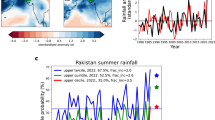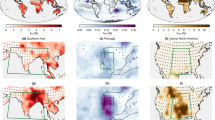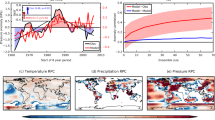Abstract
Society is vulnerable to extreme weather events and, by extension, to human impacts on future events. As climate changes weather patterns will change. The search is on for more effective methodologies to aid decision-makers both in mitigation to avoid climate change and in adaptation to changes. The traditional approach uses ensembles of climate model simulations, statistical bias correction, downscaling to the spatial and temporal scales relevant to decision-makers, and then translation into quantities of interest. The veracity of this approach cannot be tested, and it faces in-principle challenges. Alternatively, numerical weather prediction models in a hypothetical climate setting can provide tailored narratives for high-resolution simulations of high-impact weather in a future climate. This 'tales of future weather' approach will aid in the interpretation of lower-resolution simulations. Arguably, it potentially provides complementary, more realistic and more physically consistent pictures of what future weather might look like.
This is a preview of subscription content, access via your institution
Access options
Subscribe to this journal
Receive 12 print issues and online access
$209.00 per year
only $17.42 per issue
Buy this article
- Purchase on Springer Link
- Instant access to full article PDF
Prices may be subject to local taxes which are calculated during checkout
Similar content being viewed by others
Change history
28 January 2015
In the print version of this Perspective, the last sentence in Box 1 was cut off, and should have read "The model information of this specific case added with 'what-if' scenarios of sea-level rise and on changes in extreme rainfall have been provided to water managers and now aid in designing adaptation measures in a realistic setting." This error has been corrected in the online versions.
References
Zeid, A., Egeland J., Chissano J. (eds) Climate Knowledge for Action: a Global Framework for Climate Services and Empowering the Most Vulnerable (World Meteorological Organization, 2011).
Frigg, R., Stainforth, D. A. & Smith, L. A. The myopia of imperfect climate models: the case of UKCP09. Philos. Sci. 80, 886–897 (2013).
Smith, L. A. What might we learn from climate forecasts? Proc. Natl Acad. Sci. USA 4, 2487–2492 (2002).
Stainforth, D. A. et al. Confidence, uncertainty and decision-support relevance in climate predictions. Phil. Trans. R. Soc. A 365, 2145–2161 (2007).
Kunreuther, H. et al. Risk management and climate change. Nature Clim. Change, 3, 447–450 (2013).
te Linde, A. H., Bubeck, P., Dekkers, J. E. C., de Moel, H. & Aerts, J. C. J. H. Future flood risk estimates along the river Rhine. Nat. Hazards Earth Syst. Sci. 11, 459–473 (2011).
IPCC Climate Change 2013: The Physical Science Basis (eds Stocker, T. F. et al.) (Cambridge Univ. Press, 2013).
Dessai, S., Hulme, M., Lempert, R. & Pielke, R. Jr Do we need more precise and accurate predictions in order to adapt to a changing climate? Eos 90 (13), 111–112 (2009).
Goddard, L. et al. Current approaches to seasonal-to-interannual climate predictions. Int. J. Climatol. 21, 1111–1152 (2001).
van Oldenborgh, G. J., Doblas-Reyes, F. J., Wouters, B. & Hazeleger, W. Skill in the trend and internal variability in a multi-model decadal prediction ensemble. Clim. Dynam. 38, 1263–1280 (2012).
Hazeleger, W. et al. Predicting multiyear north Atlantic ocean variability. J. Geophys. Res. 118, 1087–1098 (2013).
Daron, J. D. & Stainforth, D. A. On predicting climate under climate change. Environ. Res. Lett. 8, 034021 (2013).
Suckling, E. B. & Smith, L. A. An evaluation of decadal probability forecasts from state-of-the-art climate models. J. Clim. 26, 9334–9347 (2013).
Buizza, R. et al. A comparison of the ECMWF, MSC, and NCEP global ensemble prediction Syst. Mon. Weath. Rev. 5, 1076–1097 (2005).
Smith, L. A., Du, H., Suckling, E. B. & Niehoerster, F. Probabilistic skill in ensemble seasonal forecasts. Q. J. R. Meteorol. Soc. http://dx.doi.org/10.1002/qj.2403 (2014).
Haasnoot, M. & Middelkoop, H. A history of futures: A review of scenario use in water policy studies in the Netherlands. Environ. Sci. Pol. 19–20, 108–120 (2012).
Jenkins, G. J. et al. UK Climate Projections: Briefing Report (Met Office Hadley Centre, 2009).
Held, I. The gap between simulation and understanding in climate modeling. Bull. Am. Meteorol. Soc. 86, 1609–1614 (2005).
van den Hurk, B. et al. New climate change scenarios for the Netherlands. Wat. Sci. Technol. 56, 27–33 (2007).
van den Hurk, B. et al. Drivers of mean climate change around the Netherlands derived from CMIP5. Clim. Dynam. 42, 1683–1697 (2013).
Swiss Climate Change Scenarios CH2011 (C2SM, MeteoSwiss, ETH, NCCR Climate, and OcCC, 2011).
Climate Change in Australia (CSIRO, 2007).
Berkhout, F., Hertin, J. & Jordan, A. Socio-economic futures in climate change impact assessment: using scenarios as 'learning machines'. Glob. Environ. Change 12, 83–89 (2002).
Vasileiadou, E., & Botzen, W. J. W. Communicating adaptation with emotions: the role of intense experiences in raising concern about extreme weather. Ecol. Soc. 19, 36 (2014).
Haarsma, R. J. et al. More hurricanes to hit Western Europe due to global warming. Geophys. Res. Lett. 40, 1783–1788 (2013).
Attema, J. J., Loriaux, J. M. & Lenderink, G. Extreme precipitation response to climate perturbations in an atmospheric mesoscale model. Environ. Res. Lett. 9, 14003 (2014).
Hohenegger, C., Brockhaus, P. & Schär, C. Towards climate simulations at cloud-resolving scales. Meteorol. Z. 17, 382–394 (2008).
Kendon, E. M. et al. Heavier summer downpours with climate change revealed by weather forecast resolution model. Nature Clim. Change 4, 570–576 (2014).
van Haren, R., van Oldenborgh, G. J., Lenderink, G., Collins, M. & Hazeleger, W. SST and circulation trend biases cause an underestimation of European precipitation trends Clim. Dynam. 40, 1–20 (2012).
Nakicenovic, N. & Swart, R. J. (eds) IPCC Special Report on Emissions Scenarios (Cambridge Univ. Press, 2000).
Moss, R. et al. A new approach to scenario development for the IPCC Fifth Assessment Report. Nature 463, 747–756 (2010).
O'Neill, B. C. et al. A new scenario framework for climate change research: The concept of shared socio-economic pathways. Climatic Change 122, 387–400 (2014).
Bakker, A. M. R., van den Hurk, B. J. J. M., Bessembinder, J. J. E. & Kroon, T. Reduced Climate forcings for large-scale hydrological scenario calculations. Environ. Mod. Softw. 26, 797–803 (2011).
Siegel, J. M., Shoaf, K. I., Afifi, A. A. & Bourque, L. B. Surviving two disasters: does reaction to the first predict response to the second? Environ. Behav. 35, 637–654 (2003).
Lenderink, G., van Meijgaard, E. & Selten, F. Intense coastal rainfall in the Netherlands in response to high sea surface temperatures: analysis of the event of August 2006 from the perspective of a changing climate. Clim. Dynam. 32, 19–33 (2009).
Basolo, V., Steinberg, L. J., Burby, R. J., Levine, J., Cruz, A. M. & Huang, C. The effects of confidence in government and information on perceived and actual preparedness for disasters. Environ. Behav. 41, 338–364 (2009).
Rasmijn, L. M., van der Schrier, G., Barkmeijer, J., Sterl, A. & Hazeleger, W. On the use of the forced sensitivity method in climate studies. Q. J. R. Meteorol. Soc. http://dx.doi.org/10.1002/qj.2402 (2014).
Kinter, J. L. et al. Revolutionizing climate modeling with project Athena: a multi-institutional, international collaboration. Bull. Am. Meteorol. Soc. 94, 231–245 (2013).
Hazeleger, W. et al. EC-Earth: a seamless earth-system prediction approach in action. Bull. Am. Meteorol. Soc. 91, 1357–1363 (2010).
Lenderink, G. & van Meijgaard, E. Increase in hourly precipitation extremes beyond expectations from temperature changes. Nature Geosci. 1, 511–514 (2008).
Honda, M., Inoue, J. & Yamane, S. Influence of low Arctic sea-ice minima on anomalously cold Eurasian winters. Geophys. Res. Lett. 36, L08707 (2009).
De Vries, H., Woollings, T. J., Haarsma, R. J. & Hazeleger, W. Atmospheric blocking and its relation to jet changes in a future climate. Clim. Dynam. 41, 2643–2654 (2013).
Funtowicz, S. O. & Ravetz, J. R. Uncertainty and Quality in Science for Policy (Kluwer, 1990).
van der Sluijs, J. P., Petersen, A. C., Janssen, P. H. M., Risbey, J. S. & Ravetz, J. R. Exploring the quality of evidence for complex and contested policy decisions. Environ. Res. Lett. 3, 024008 (2008).
Petersen, A. C. Simulating Nature: A Philosophical Study of Computer-Simulation Uncertainties and Their Role in Climate Science and Policy Advice 2nd edn (CRC Press, 2012).
Hazeleger, W. et al. EC-Earth: A Seamless Earth-System Prediction Approach in Action. Bull. Am. Meteorol. Soc. 91, 1357–1363 (2010).
de Winter, R. C., Sterl, A. & Ruessink, B. G. Wind extremes in the North Sea basin under climate change: an ensemble study of 12 CMIP5 GCMs. J. Geophys. Res. Atmos. 118, 1601–1612 (2013).
Kew, S. F., Selten, F. M., Lenderink, G. & Hazeleger, W. The simultaneous occurrence of surge and discharge extremes for the Rhine delta. Nat. Hazards Earth Syst. Sci. 13, 2017–2029 (2013).
Trenberth, K. E. Conceptual framework for changes of extremes of the hydrological cycle with climate change. Climatic Change 42, 327–339 (1999).
Katsman, C. A. et al. Exploring high-end scenarios for local sea level rise to develop flood protection strategies for a low-lying delta - the Netherlands as an example. Climatic Change 109, 617–649 (2011).
Katsman, C. A., Hazeleger, W., Drijfhout, S. S., van Oldenborgh G. J. & Burgers, G. J. H. Climate scenarios of sea level rise for the northeast Atlantic Ocean: a study including the effects of ocean dynamics and gravity changes induced by ice melt. Climatic Change 91, 351–374 (2008).
Acknowledgements
We thank Jan Gooijer of regional water authority Noorderzijlvest for providing the observations shown in Figure B1 and his feedback on the use of Tales in practice. W.H., G.J.v.O., and B.vd.H. were co-sponsored by Knowledge for Climate Theme 6 project E.M, and E. V. were co-sponsored NWO/KvK project Bridging the Gap between stakeholders and climate scientists (NWO 830.10.008). L.A.S. and D.A.S. acknowledge the support of LSE's Grantham Research Institute on Climate Change and the Environment, LSE's Centre for Climate Change and Economics and Policy funded by the ESRC and Munich Re, and UK EPSRC grant EP/K013661/1. L.A.S. is grateful for the continuing support of the Master and Fellows of Pembroke College, Oxford.
Author information
Authors and Affiliations
Contributions
W.H., D.S., A.P., B. vd. H.,G.J. v O., and L.S. developed the main idea of Tales, W.H. wrote the majority of the first draft; A.P., W.H., E.M., and E.V. provided insights on interactions between climate scientists and users reflected in the text; G.J.v.O. provided input on the forecast quality section; B.vd.H. provided insights on local vulnerability reflected in the article and the box; L.S. and D.S. provided insights on the impacts and identification of model inadequacies in climate simulation models. All authors contributed at different stages to drafts of the article with a major final edit by D.S. and L.S.
Corresponding author
Ethics declarations
Competing interests
The authors declare no competing financial interests.
Rights and permissions
About this article
Cite this article
Hazeleger, W., van den Hurk, B., Min, E. et al. Tales of future weather. Nature Clim Change 5, 107–113 (2015). https://doi.org/10.1038/nclimate2450
Received:
Accepted:
Published:
Issue Date:
DOI: https://doi.org/10.1038/nclimate2450
This article is cited by
-
Systematic review of the uncertainty of coral reef futures under climate change
Nature Communications (2024)
-
Dynamic adaptive engineering pathways for mitigating flood risks in Shanghai with regret theory
Nature Water (2023)
-
Increased wintertime European atmospheric blocking frequencies in General Circulation Models with an eddy-permitting ocean
npj Climate and Atmospheric Science (2023)
-
Storylines for unprecedented heatwaves based on ensemble boosting
Nature Communications (2023)
-
Advancing research on compound weather and climate events via large ensemble model simulations
Nature Communications (2023)



